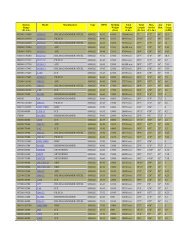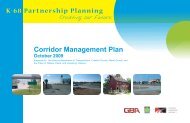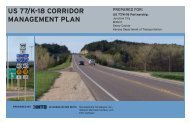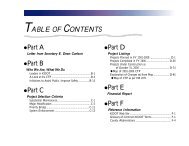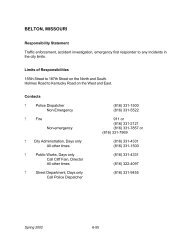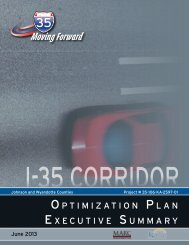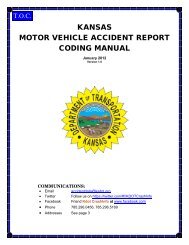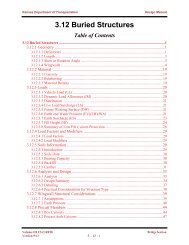Access Management Policy 2013 - Kansas Department of ...
Access Management Policy 2013 - Kansas Department of ...
Access Management Policy 2013 - Kansas Department of ...
Create successful ePaper yourself
Turn your PDF publications into a flip-book with our unique Google optimized e-Paper software.
KDOT <strong>Access</strong> <strong>Management</strong> <strong>Policy</strong><br />
3.1 KDOT access planning<br />
KDOT supports planning for areas or corridors with significant growth potential. KDOT staff<br />
members work with cities, counties, metropolitan planning organizations (MPO), and other local<br />
stakeholders to identify potential developments and formalize plans to coordinate land use changes,<br />
transportation improvements, and future access. These planning processes are collaborative with<br />
local transportation partners providing input and feedback so communities, land owners, and<br />
developers are treated equitably and transportation needs are met. Collaboration leads to better<br />
planning.<br />
All six KDOT Districts have a District <strong>Access</strong> <strong>Management</strong> Plan that identifies growth corridors or<br />
areas that need access planning to preserve capacity and functional integrity. Plan summaries and<br />
maps for all six Districts are included in Chapter 8. The maps show the classifications <strong>of</strong> state<br />
routes and highlight planned corridors and areas where development is anticipated or currently<br />
occurring. Recognition <strong>of</strong> such growth corridors provides a base for discussions with local <strong>of</strong>ficials<br />
to plan coordinated development and highway access.<br />
3.1.1 <strong>Access</strong> planning instruments<br />
As outlined in <strong>Kansas</strong> Statutes Annotated (K.S.A.) 68-169, the Secretary <strong>of</strong> Transportation is<br />
authorized to enter into written agreements with cities and counties to establish planned corridors<br />
and administer District <strong>Access</strong> <strong>Management</strong> Plans. To meet the needs <strong>of</strong> transportation partners<br />
and the diverse <strong>Kansas</strong> highway network, KDOT currently uses four types <strong>of</strong> access planning<br />
instruments (or documents) each with different levels <strong>of</strong> complexity and analysis as shown in<br />
Table 3-1.<br />
Table 3-1. Summary <strong>of</strong> planning instruments by complexity<br />
The planning process associated with<br />
Instrument Type<br />
Complexity<br />
these instruments involves varying<br />
Memorandum <strong>of</strong> Understanding (MOU) Basic<br />
degrees <strong>of</strong> engineering analyses and<br />
<strong>Access</strong> management plan<br />
Intermediate<br />
consideration <strong>of</strong> land-use and<br />
development impacts. The goal is to Area transportation plan<br />
Complex<br />
balance mobility and accessibility. In Corridor management plan<br />
Complex<br />
addition, these processes include<br />
collaboration with local government, consultation with affected transportation stakeholders, and<br />
public involvement. Extensive public involvement generally accompanies more complex plans.<br />
(This can include multiple public meetings, multiple briefings <strong>of</strong> public <strong>of</strong>ficials, a project website,<br />
and social media applications to help distribute information.) These planning instruments are <strong>of</strong>ten<br />
developed by a consultant familiar with access management and qualified to prepare transportation<br />
plans.<br />
Each planning instrument constitutes a commitment <strong>of</strong> the local partners and KDOT to consider the<br />
provisions and recommendations <strong>of</strong> the planning document. The access management plans, area<br />
transportation plans, and corridor management plans include interlocal cooperation agreements<br />
signed by local <strong>of</strong>ficials stating support for the plan and willingness to consider its provisions and<br />
recommendations as part <strong>of</strong> the decision-making process.<br />
The following sections describe each planning instrument in greater detail.<br />
3 - 2 | Page | January <strong>2013</strong> Chapter 3—<strong>Access</strong> planning



